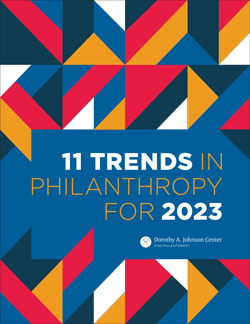More Nonprofit Employees are Moving to Unionize


 This article was first published in our 11 Trends in Philanthropy for 2023 report. Explore all 11 trends in the report.
This article was first published in our 11 Trends in Philanthropy for 2023 report. Explore all 11 trends in the report.
Want the latest trends, research, and more delivered right to your inbox? Subscribe to the Johnson Center email newsletter.
Unionization efforts at massive, international corporations like Starbucks and Amazon have grabbed headlines — and time on judicial dockets — all over the U.S. After decades of declining enrollment and evaporating influence, union sentiment is on the rise. “Seventy-one percent of Americans now approve of labor unions,” Gallup’s Justin McCarthy reported in August 2022. “Although statistically similar to last year’s 68%, it is up from 64% before the pandemic and is the highest Gallup has recorded on this measure since 1965” (para. 1).
It is far too early to say whether the U.S. is on the cusp of a new dawn for organized labor. U.S. employees’ overall participation in unions continues to decline — the Bureau of Labor Statistics (2022) cites the loss of 241,000 union members in 2021. But there are some signs that suggest it may be headed for a great turnaround. The National Labor Relations Board reported that “2,510 union representation petitions were filed with NLRB’s 48 Field Offices” in Fiscal Year 2022, “a 53% increase from the 1,638 petitions filed in FY2021” (para. 1).
“Unionization efforts are coming from both sides — from nonprofit employees eager to engage in collective bargaining and from existing labor unions eager to expand membership.”
While most of the national conversation understandably focuses on the role and popularity of unions within the corporate workforce, a parallel movement for unionization is taking place within the nonprofit sector, as well.
The International Federation of Professional and Technical Engineers (IFPTE) Local 70 was established in 1998. In 2018, in honor of its 20th anniversary and its rapid growth over the previous decade, IFPTE Local 70 rebranded as the Nonprofit Professional Employees Union. From 2010 to 2017, NPEU’s membership jumped from 70 nonprofit professionals to 250 (NPEU, 2018). Today, NPEU counts around 1500 members representing nearly 50 organizations (Sabbaghi, 2022).
Those organizations run the gamut, from the Economic Policy Institute and National Women’s Law Center to Food & Water Watch and the ACLU. That spectrum is reflected by the wide array of unionized nonprofits across the field. Indeed, organizations of all mission areas — from museums to think tanks, universities, and environmental groups — have been steadily joining the union movement.
NPEU even disputes the BLS statistics on declining union membership. According to Zane McNeill from Law @ the Margins in March 2022, NPEU’s then-president (now international vice president) Katie Barrows “believe[s] that the BLS statistics do not reflect gains in new industries, such as the non-profit sector, which she has seen major growth in the past few years” (para. 5).
Unionization efforts are coming from both sides — from nonprofit employees eager to engage in collective bargaining and from existing labor unions eager to expand membership. As early as 2000, Jan Masaoka (now CEO of CalNonprofits) noted in Nonprofit Quarterly that “labor unions are increasingly attracted to community-based nonprofit organizations. One reason for labor’s interest is the rapid growth of the nonprofit sector, both in terms of the size of its workforce and the amount of revenue generated” (para. 2).
Today, many observers are commenting on the fact that nonprofit practitioners are increasingly interested in unionization not only as a way to boost salaries and workplace power but as a means of achieving a host of social goals (Karlin, 2022; Lindsay, 2022; Nonprofit Employees United, 2022; Small, 2022). Sid Davis of GrantStation wrote that
COVID-19 highlights the fact that unionization is about more than pay. But it’s also about more than healthcare. Newly unionized workers have negotiated anti-discrimination and anti-harassment policies, flexible scheduling, leadership development, remote work policies, DEI (diversity, equity, and inclusion) commitments, and more. Unionization can also result in the improvement or creation of severance packages. (2021, para. 5)
One mission area where this trend is gaining considerable ground is within the art world. In 2019, ArtNet’s Catherine Wagley reported on the wave of unionization happening within art museums:
What makes this shift a ‘movement, not a trend’1 … is the fact that workers from across different institutions, many of whom had not spoken to one another in the past, are exchanging strategic advice and sharing information about pay and benefits. In the process, they are attempting to thwart the art world’s own exclusivity in a way that could have a lasting and widespread impact. (para. 8)
In the past three years, staff at some of the best-known art museums in the country have established unions, including the Philadelphia Museum of Art, the Art Institute of Chicago, the Solomon R. Guggenheim Museum, and the Museum of Tolerance (Small, 2022; Wagley, 2019). Workers at the Museum of Modern Art first unionized in the early 1970s; today, MoMA houses five unions (Wagley, 2022).
Don Howard, president and CEO of the James Irvine Foundation, and Rachel Korberg, co-founder and executive director of the Families and Workers Fund, tried to persuade philanthropy to support workers’ rights in a 2022 op-ed for The Chronicle of Philanthropy. “State and federal governments have the primary responsibility for expanding collective bargaining rights and strengthening labor protections,” they wrote. “But philanthropy can help by supporting groups that raise awareness of labor laws, monitor enforcement, and help workers advocate for reforms” (para. 12).
Similarly, Hayley Brown (current president of NPEU) and Katie Barrows (2022) argued that “Donors have recognized the effectiveness of these organizations and have chosen to contribute accordingly. When progressive nonprofit staff form unions, they make their organizations more credible by compelling them to practice what they preach” (para. 9).
The arguments are there, but whether they will ultimately change hearts and minds, or inspire those who were not otherwise considering worker collectives to seek them remains to be seen. What may also prove difficult is tracking this trend within philanthropy over time, as BLS does not provide nonprofit sector-specific employment statistics at all, let alone specifically for unionized nonprofit employees.
The nature of work and the workplace will continue to undergo a radical reimagination in the wake of the global pandemic. Countless nonprofits and funders are engaged in these conversations with their team members and with the communities in which they work. For partnerships committed to building community wealth, sector leadership talent, and workplace equity, unionization may become a more intriguing and popular tool.
_______________
1 The authors wish to acknowledge that members of unionization efforts within art museums have chosen to use the word “movement” over “trend” to convey their seriousness and long-term commitment to their goals. Our annual 11 Trends in Philanthropy report uses the word “trend” to imply a shift in the field. This word choice alone does not intend to imply any conclusion regarding the value or staying power of any particular efforts.


Brown, H., & Barrows, K. (2022). Commentary: Nonprofits need unions too. Tribune News Service. https://www.msn.com/en-us/news/us/commentary-nonprofits-need-unions-too/ar-AAZYZsk
Bureau of Labor Statistics. (2022, January 20). News release. Union members – 2021. https://www.bls.gov/news.release/pdf/union2.pdf
Davis, S. (2021, January 21). Unionization trend continues in nonprofit sector. GrantStation. https://grantstation.com/gs-insights/Unionization-Trend-Continues-in-Nonprofit-Sector
Howard, D., & Korberg, R. (2022, October 25). Growing public support for worker rights should be matched by increased philanthropic giving. The Chronicle of Philanthropy. https://www.philanthropy.com/article/growing-public-support-for-worker-rights-should-be-matched-by-increased-philanthropic-giving
Karlin, R. (2022, June 26). Nonprofit, human service workers are starting to unionize. Low pay, high workload, and COVID was a turning point. Times Union. https://www.timesunion.com/business/article/Non-profit-human-services-workers-are-starting-17261456.php
Lindsay, D. (2022, December 12). Many nonprofit salaries are going public thanks to new laws and the job market. The consequences could be big. The Chronicle of Philanthropy. https://www.philanthropy.com/article/show-me-the-money-why-salaries-once-fuel-for-office-gossip-are-about-to-go-public
Masaoka, J. (2000, December 21). A house divided: How nonprofits experience union drives. Nonprofit Quarterly. https://nonprofitquarterly.org/a-house-divided-how-nonprofits-experience-union-drives/
McCarthy, J. (2022, August 30). U.S. approval of labor unions at highest point since 1965. Gallup. https://news.gallup.com/poll/398303/approval-labor-unions-highest-point-1965.aspx
McNeill, Z. (2022, March 2). Behind the wave of non-profit unionization: Why are NGOs unionizing? Law @ the Margins. https://lawatthemargins.com/behind-the-wave-of-non-profit-unionization-why-are-ngos-unionizing/
National Labor Relations Board. (2022, October 6) Election petitions up 53%, board continues to reduce case processing time in FY22. News and Publications. https://www.nlrb.gov/news-outreach/news-story/election-petitions-up-53-board-continues-to-reduce-case-processing-time-in
Nonprofit Employees United. (2022, June). Why workers at progressive nonprofits are unionizing. https://www.nonprofitemployeesunited.org/2022/06/why-workers-at-progressive-nonprofits-are-unionizing/
Nonprofit Professionals Employees Union. (2018, February 6). IFPTE Local 70 celebrates 20th anniversary with new name, website and logo. https://npeu.org/news/2018/2/1/new-name-website-and-logo
Sabbaghi, M. (2022, September 6). Nonprofit workers shouldn’t be turned away because unions are at “Capacity.” In These Times. https://inthesetimes.com/article/nonprofit-workers-union-labor-nlrb
Small, Z. (2022, February 21). U.S. museums see rise in unions even as labor movement slumps. The New York Times. https://www.nytimes.com/2022/02/21/arts/design/museums-unions-labor.html
Wagley, C. (2019, November 25). Museum workers across the country are unionizing. Here’s what’s driving a movement that’s been years in the making. ArtNet. https://news.artnet.com/market/union-museum-analysis-1714716